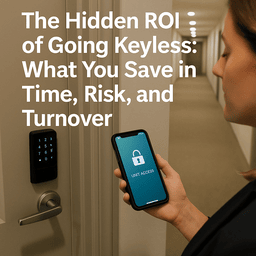
Introduction: Going Keyless Is More Than Just Convenience
Upgrading to smart locks and mobile access control is often seen as a “nice-to-have” feature—something to impress younger renters or modernize an older building. But for property managers and owners, the real value of going keyless isn’t just in sleek tech.
It’s in what you save:
💰 Time spent managing keys
⚠️ Risks from unauthorized access
🔁 Costs from resident and staff turnover
📉 Hidden inefficiencies that drag down operations
In this article, we’ll break down the true return on investment (ROI) of ditching traditional metal keys for a smart, mobile-first system—and why “going keyless” might be the smartest financial decision your property can make this year.
k
k
1. The Time Drain of Traditional Keys
Let’s start with what property managers know all too well:
Keys eat up time. A lot of it.
Every time you:
-
Issue or collect a key during move-in or move-out
-
Replace a lost key
-
Re-key a lock after turnover
-
Escort a vendor or maintenance tech who forgot theirs
-
Track down who has access to what…
…you're burning time, increasing risk, and diverting your team from more valuable tasks.
⏳ Smart Lock Time Savings:
With mobile or digital access:
-
Residents can unlock via phone or PIN
-
Credentials can be granted remotely—no office visit required
-
Maintenance and vendors can receive time-limited digital keys
-
Re-keying is replaced by a quick credential update in the system
✅ Estimated time savings: 5–10 hours per turnover
✅ Staff freed up: 1–2 hours per week (per 100 units)
k
k
2. The Cost of Re-Keying and Lockouts
Re-keying a single unit door can cost $75 to $250, depending on your market and system. Multiply that by every turnover, lockout, or lost key scenario—and it adds up fast.
🔒 Smart Locks Eliminate:
-
Rekeying costs (just revoke or reassign a mobile credential)
-
Emergency locksmith visits
-
Lockbox confusion for vendors
-
Long wait times for residents locked out
✅ Average property savings: $3,000–$10,000 annually (100+ unit buildings)
✅ Bonus: Reduces after-hours calls and headaches for on-call staff
k
k
3. Reduced Risk = Reduced Liability
Lost or copied keys pose a serious security risk. If you don’t rekey promptly, unauthorized individuals could retain access to a unit—leaving your building vulnerable.
And when that results in theft, vandalism, or worse, the property can be held liable for negligence.
🛡️ Keyless Systems Improve Security:
-
Mobile credentials can’t be copied or duplicated
-
Every entry is logged and timestamped
-
Temporary access can be restricted by time and location
-
Audit trails offer legal protection if disputes arise
✅ Safer for residents
✅ Easier for managers to enforce access policies
✅ Adds a digital layer of accountability
k
k
4. Higher Resident Satisfaction = Lower Turnover
Modern renters—especially Gen Z and Millennials—expect tech-enabled living. In fact, surveys show that over 60% of renters prefer properties with smart access features, and are more likely to renew leases where they feel secure and in control.
Smart Access Boosts Retention:
-
Mobile entry means fewer lockouts or key hassles
-
Guests and deliveries are easier to manage
-
Residents feel safer knowing access is tracked
Better experience = fewer move-outs = more predictable revenue.
✅ Even a 5% reduction in turnover can save $10,000–$20,000/year
(considering marketing, cleaning, maintenance, and vacancy time)
k
k
5. Streamlined Vendor and Maintenance Access
Juggling vendor schedules and spare keys is a common source of stress. With a smart system, you can issue temporary or single-use credentials directly from your dashboard.
🚪 Key Benefits:
-
Avoid scheduling conflicts or delays
-
Prevent unauthorized access to other units
-
See exactly when a vendor entered or exited a space
✅ Faster work orders
✅ Lower risk of lost keys or missed appointments
✅ Increased trust from residents who want secure unit entry
k
k
6. Better Data = Smarter Decisions
Smart access systems don’t just secure doors—they collect data. You can track:
-
Amenity usage (who enters the gym, pool, or lounge)
-
Peak maintenance access times
-
Access patterns that might signal misuse or inefficiency
Use this information to:
-
Adjust staffing or cleaning schedules
-
Identify high-traffic areas for upgrades
-
Spot security issues before they become complaints
✅ Data = insights = better management
k
k
Hidden ROI Summary: What You Actually Save
| Category | Traditional Cost | Smart Access Savings |
|---|---|---|
| Rekeying | $75–$250 per unit | $0 (digital credential reassignment) |
| Lockouts | $100+ per call | Remote unlocks via app |
| Turnover labor | 5–10 hrs per unit | 1–2 hrs saved |
| Vendor access delays | Missed appointments, tenant frustration | Scheduled & logged entry |
| Lost keys | $25–$100 per reissue | Mobile re-credentialing |
| Liability risk | $$$ (lawsuits, claims) | Audit trails and secure logs |
Total Potential Annual ROI for a 150-unit property:
👉 $15,000 to $40,000+, depending on turnover, staffing, and incident rates.
k
k
Final Thoughts: The Case for Going Keyless
Yes, smart locks are modern. Yes, they look cool.
But the real reason to upgrade? They make your property safer, leaner, and more profitable.
In today’s multifamily environment, efficiency and resident trust are your strongest assets. Going keyless isn’t just about technology—it’s about turning everyday tasks into strategic wins.
j
j
Ready to Ditch the Keys?
SSP helps multifamily properties implement turnkey smart access solutions—from mobile entry systems and digital locks to video intercoms and real-time monitoring.
🔑 Let’s unlock your property’s hidden ROI.


